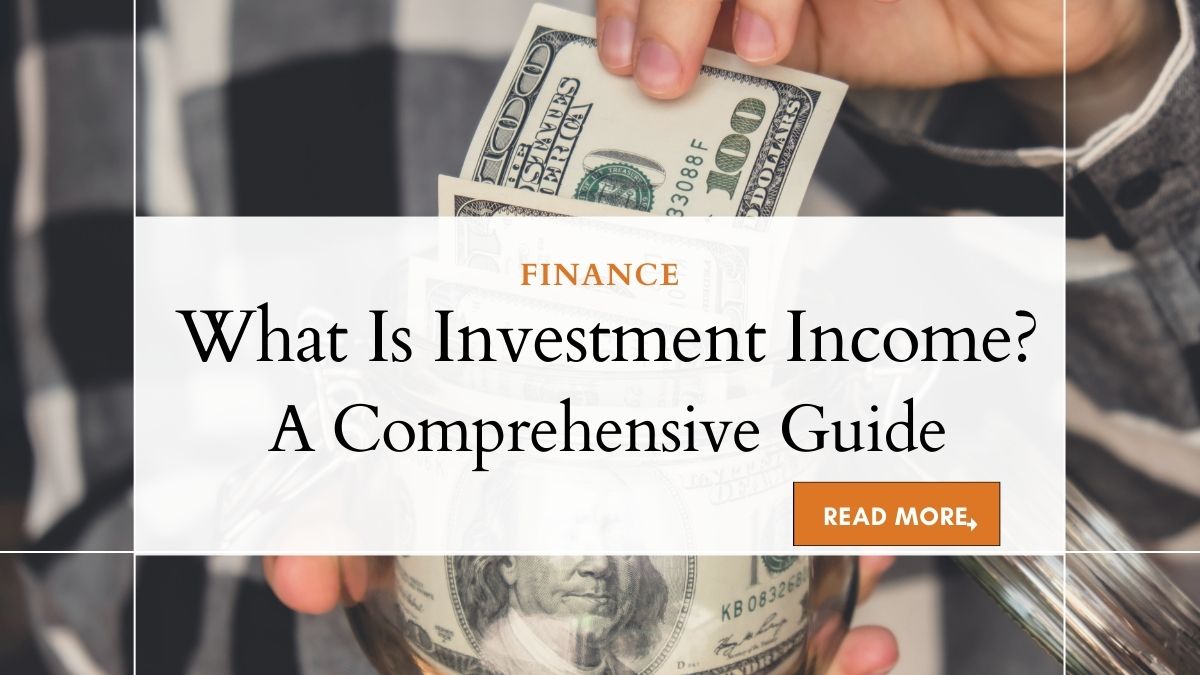
Investment income is a crucial component of personal finance, often serving as a reliable source of cash flow outside of regular employment income.
It can come from various sources, including but not limited to dividends, interest income, capital gains, and rental income.
This blog post will delve into the concept of investment income, its importance in wealth building, and strategies to maximize it.
Also, you can able to know,
What Is Investment Income?
In this section, we delve into the concept of investment income, distinguishing it from other types of income and emphasizing its role in wealth accumulation.
We define investment income, differentiate it from other income types, and discuss its significance in building wealth.
This foundational knowledge will help you appreciate the value of investment income in your financial journey.
Definition of Investment Income
Investment income refers to the money earned from investing in financial assets or leasing property.
It is the return received on an investment, which can be in the form of interest, dividends, capital gains, or rental income.
Differentiating Investment Income from Other Types of Income
Unlike employment income, which is earned by providing services or selling goods, investment income is generated by making your money work for you.
It is passive income that grows over time, requiring little to no effort on your part once the initial investment is made.
Significance of Investment Income in Wealth Building
Investment income plays a pivotal role in wealth building. It provides an additional stream of income, helping to increase overall earnings and financial stability.
Moreover, it allows for the power of compounding, where the income earned is reinvested to generate further income.
Types of Investment Income
Here, we explore the various forms of investment income, namely dividends, interest income, capital gains, and rental income.
Each subsection provides an in-depth look at these income types, their characteristics, and their roles in an investment portfolio.
Understanding these different types of investment income can help you make informed decisions about where to invest your money.
Dividends
1. Exploring Dividends as a Source of Investment Income: Dividends are payments made by corporations to their shareholders, typically from their profits. They are a form of investment income for individuals who own stocks or mutual funds.
2. Dividend Stocks and their Role in Generating Income: Dividend stocks are shares in companies that regularly distribute dividends. They are an attractive investment for income-focused investors, providing a steady stream of income in addition to potential capital appreciation.
3. Dividend Reinvestment Plans (DRIPs) and their Benefits: DRIPs allow investors to reinvest their dividends back into more shares of the company, often at a discount. This strategy can significantly enhance wealth over time due to the power of compounding.
Interest Income
1. Defining Interest Income and its Importance: Interest income is earned from lending money, whether to a bank (through a savings account or certificate of deposit), a company (through corporate bonds), or the government (through treasury securities).
2. Examining Interest-Bearing Investments (e.g., Bonds, Certificates of Deposit): Interest-bearing investments like bonds and certificates of deposit are popular for their predictable returns and lower risk compared to stocks. They pay a fixed interest rate over a specified period, providing a steady income stream.
3. Calculating and Maximizing Interest Income: Interest income can be calculated using the principal amount, interest rate, and time period. To maximize interest income, investors can opt for investments with higher interest rates or compound interest, and reinvest the earned interest.
Capital Gains
1. Understanding Capital Gains and their Relationship to Investment Income: Capital gains are the profits made from selling an investment for more than its purchase price. They contribute to investment income when realized, i.e., when the asset is sold.
2. Differentiating Short-term and Long-term Capital Gains: Capital gains are categorized as short-term (held for one year or less) or long-term (held for more than one year), with different tax implications. Long-term capital gains are generally taxed at a lower rate, incentivizing long-term investing.
3. Strategies for Managing and Optimizing Capital Gains: Investors can manage and optimize capital gains by holding onto investments for the long term, offsetting capital gains with capital losses, and strategically timing the sale of assets.
Rental Income
1. Exploring Real Estate as a Source of Investment Income: Rental income, derived from leasing out real estate properties, is a common form of investment income. It provides a regular and predictable income stream, along with potential property value appreciation.
2. Pros and Cons of Rental Property Investments: While rental properties can provide steady income and tax benefits, they also come with responsibilities like property management and maintenance. Moreover, real estate is not as liquid as stocks or bonds, making it harder to sell quickly if needed.
3. Tips for Successful Rental Income Generation: Successful rental income generation involves choosing the right property, setting a competitive rental rate, maintaining the property well, and managing tenants effectively.
Investment Income Taxation
In this part, we discuss the tax implications of investment income. We provide an overview of how different types of investment income dividends, capital gains, and interest income are taxed.
We also share strategies to minimize the impact of taxes on your investment income. This knowledge is crucial for effective financial planning and maximizing your after-tax returns.
Overview of Taxation on Investment Income
Investment income is subject to taxation, with the rates varying based on the type of income and the investor’s tax bracket.
Understanding these taxes is crucial for effective investment planning.
Taxation of Dividends and Capital Gains
Qualified dividends and long-term capital gains are generally taxed at a lower rate than ordinary income.
However, non-qualified dividends and short-term capital gains are taxed as ordinary income.
Taxation of Interest Income
Interest income is typically taxed as ordinary income. However, some types of interest, like that from municipal bonds, may be exempt from federal and/or state taxes.
Tax Strategies to Minimize the Impact on Investment Income
Tax-efficient investing strategies can help minimize the tax impact on investment income.
These include holding investments for the long term, investing in tax-advantaged accounts, and strategically realizing capital gains and losses.
Investment Income vs. Active Income
This section contrasts investment income with active income, highlighting the differences, benefits, and drawbacks of each.
We discuss the importance of balancing both types of income for financial stability. Understanding these differences can help you better manage your overall income and financial health.
The Difference Between Investment Income and Active Income
While active income is earned by trading time for money, investment income is earned by making your money work for you.
The former requires active work, while the latter requires initial investment and strategic management.
Comparing the Benefits and Drawbacks of Investment Income
Investment income offers the benefits of passive earnings, potential for high returns, and tax advantages.
However, it also comes with risks, including potential loss of principal and market volatility.
Balancing Investment Income and Active Income for Financial Stability
For financial stability, it’s important to balance active income with investment income.
While active income provides immediate cash flow, investment income can grow wealth over time and provide financial security in the long run.
Building a Diversified Investment Income Portfolio
In this segment, we discuss the importance of diversification in an investment income portfolio.
We delve into the process of allocating investments across different asset classes and the considerations of risk and return in portfolio construction.
This information can guide you in building a balanced and diversified portfolio that aligns with your financial goals and risk tolerance.
Importance of Diversification for Investment Income
Diversification, or spreading investments across various asset classes, is key to managing risk in an investment income portfolio.
It can help smooth out returns and protect against losses in any one investment.
Allocating Investments Across Different Asset Classes
Investment allocation involves dividing your portfolio among different asset classes like stocks, bonds, and real estate.
The right allocation depends on your financial goals, risk tolerance, and investment horizon.
Considering Risk and Return in Investment Income Portfolio
Every investment comes with a trade-off between risk and return. Higher potential returns often come with higher risk.
Therefore, it’s important to consider both factors when building an investment income portfolio.
Strategies for Maximizing Investment Income
In the final section, we share strategies to maximize your investment income.
We discuss the benefits of reinvesting income, setting realistic income targets, evaluating investment opportunities, and regularly reviewing and adjusting your investment strategies.
These strategies can help you optimize your investment income and accelerate your wealth-building journey.
Reinvesting Investment Income for Compound Growth
Reinvesting your investment income can lead to compound growth, where you earn income not just on your original investment, but also on the income you’ve reinvested.
Setting Realistic Income Targets and Tracking Progress
Setting realistic income targets and regularly tracking your progress can help you stay focused and make necessary adjustments to your investment strategy.
Evaluating Investment Opportunities and Making Informed Decisions
Investing requires careful evaluation of opportunities and informed decision-making.
This involves understanding the potential risks and returns, and considering how each investment fits into your overall portfolio.
Regularly Reviewing and Adjusting Investment Income Strategies
Investment strategies should be reviewed and adjusted regularly based on changes in financial goals, market conditions, and personal circumstances.
FAQs
To help you better understand the concept of investment income, we’ve compiled a list of frequently asked questions.
These questions touch on the definition of investment income, its different types, taxation, the importance of diversification in an investment portfolio, and strategies for maximizing investment income.
The answers to these questions provide a concise summary of the key points discussed in the article. Let’s dive in.
What is investment income and how does it differ from active income?
Investment income refers to the money earned from investing in financial assets or leasing property.
It is the return received on an investment, which can be in the form of interest, dividends, capital gains, or rental income.
Unlike active income, which is earned by providing services or selling goods, investment income is generated by making your money work for you.
It is passive income that grows over time, requiring little to no effort on your part once the initial investment is made.
What are the different types of investment income?
The different types of investment income include dividends, interest income, capital gains, and rental income.
Dividends are payments made by corporations to their shareholders, typically from their profits.
Interest income is earned from lending money, such as to a bank through a savings account or certificate of deposit.
Capital gains are the profits made from selling an investment for more than its purchase price. Rental income is derived from leasing out real estate properties.
How is investment income taxed?
Investment income is subject to taxation, with the rates varying based on the type of income and the investor’s tax bracket.
Qualified dividends and long-term capital gains are generally taxed at a lower rate than ordinary income.
However, non-qualified dividends and short-term capital gains are taxed as ordinary income.
Interest income is typically taxed as ordinary income, but some types, like that from municipal bonds, may be exempt from federal and/or state taxes.
What is the importance of diversification in an investment income portfolio?
Diversification, or spreading investments across various asset classes, is key to managing risk in an investment income portfolio.
It can help smooth out returns and protect against losses in any one investment. Diversification allows for a balance in the portfolio, ensuring that potential losses in one investment can be offset by gains in another.
What are some strategies for maximizing investment income?
Some strategies for maximizing investment income include reinvesting your investment income for compound growth, setting realistic income targets and regularly tracking your progress, carefully evaluating investment opportunities and making informed decisions, and regularly reviewing and adjusting your investment strategies based on changes in financial goals, market conditions, and personal circumstances.
Don’t miss: 18 Essential Tips for Business Capital Management
The bottom line
Investment income is a key component of personal financial planning, offering a way to grow wealth and achieve financial stability.
By understanding the different types of investment income, their tax implications, and strategies to maximize them, you can optimize your investment income and work towards your financial goals.
Remember, investing is not a one-time activity but a continuous process that requires regular review and adjustment.
So, start exploring your investment income opportunities today and take a step closer to financial freedom.














